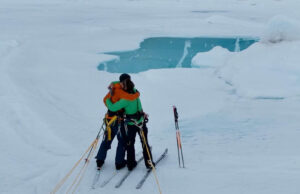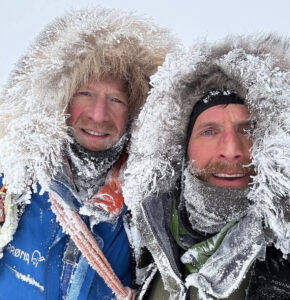Contrary to what you might think, quite a few fungi can be found in the Far North. In Svalbard, 1,200 species have been documented, while somewhere between 600 and 700 species have been reported from Greenland.
In 2007, I was doing a survey of fungi in the vicinity of Kuujjuaq, Nunavik. There happened to be a large number of species there, too. At one point, a local Inuk who was helping me collect specimens brought me a mushroom-shaped species. I already had the species on my list, but as I gave it back to him, I happened to mention that it was a decent edible. The fellow shook his head. Mushrooms, he said, are tunitinging (caribou food). And if they’re caribou food, he added, they’re definitely not human food.
Myths about mushrooms
Different Inuit groups have different words and phrases to indicate their aversion to eating mushrooms. East Greenlanders call mushrooms qivittoq sopa, on the assumption that the cannibalistic monster called a qivittoq uses their frequent slime as soap. Of course, this makes them flagrantly inedible.
The Inuit of the Central Canadian Arctic believe mushrooms are the anaq (shit) of shooting stars. Across the night sky, a shooting star will hurtle in the late summer or fall, leaving a trail of detritus behind it, and in the next day or two, there are mushrooms on the tundra.
“You wouldn’t want to invite a friend to dinner, telling him you’re serving the anaq of a shooting star, would you?” an Inuk in Baker Lake, Nunavut, once told me.

Lactarius (Milk Cap) in the snow, East Greenland. Photo: Lawrence Millman
In Alaska, the Inupiaq call mushrooms argaignag (that which makes your hands fall off), so you shouldn’t touch, much less pick them. If you do, you should blow immediately on your hand or it will soon fall off. At the very least, it will become rancid.
The Yupik believe mushrooms are the ears of evil spirits, and they call them chertovysuhi ushi (devil’s ears). Thus if you say something personal or confidential if you’re anywhere near one of them, you’ll be sorry…and you’ll be even sorrier if you decide to eat them.
Medicinal uses
Here I should mention that the Inuit do have non-culinary uses for certain fungi which aren’t mushroom-shaped. For example, they use the spores of a puffball as a styptic. If someone jabs their hand with a knife or a harpoon, they might take a puffball and squeeze the spores into the wound. Chitosan, a component in fungal cell walls, will bond with red blood cells and form a clot that will quickly stop the bleeding. Also, those spores have splendid antibiotic properties, like many other fungi (think penicillin, which is derived from the fungus Penicillium chrysogenum), so there’s very little chance the wound will end up with a bacterial infection.
You might think that a belief that all mushrooms are repulsive is a way of protecting one’s fellow humans from eating poisonous ones and kicking the proverbial bucket. But I haven’t encountered any potentially fatal species in the Arctic. Yes, there are several species that can cause gastroenterological distress, such as the Fly Agaric (Amanita muscaria) and the Sickener (Russula emetica). But could such mushrooms have created a phobia that stretches all the way from Alaska to East Greenland? Would they have inspired an Inuk I once met in Rankin Inlet to say “I’d rather eat bear scat?”
Probably not.

Amanita Muscaria, central Alaska. It can cause stomach upsets but is not fatal. Photo: Lawrence Millman
Why the bad reputation?
So from whence comes this fear of an organism that’s considerably less fearful than, for instance, a mother polar bear protecting her cubs? With respect to its origin, Canadian ethnobotanist Nancy Turner suggests that the Pleistocene ancestors of the Inuit may have brought this fear with them across the Bering Strait from northeastern Siberia. And with respect to the phobia itself, a doctor friend of mine thinks many Inuit may get (or may have gotten) some sort of idiosyncratic reaction after they’ve eaten mushrooms — something similar to lactose intolerance.
I’d like to offer my own conjecture, which is as follows:
A person needs plenty of calories to survive as a hunter-gatherer in the Arctic. While mushrooms are full of protein, they don’t have much in the way of calories (aka, fat). If a person happens to be starving, and he or she eats something with little or no calories, their hunger will be accelerated. That’s because a starving person’s body metabolizes its own calories, and eating something rich in protein speeds up rather than slows down that metabolic process. The commonly used phrase “rabbit starvation” describes the effect of eating exclusively lean meat. “Mushroom starvation” might be considered an equivalent phrase, although I can’t imagine many Inuit suffering from it.
And yet as the hunter-gatherer lifestyle is slowly but surely dying out in the Arctic, the Inuit phobia about mushrooms would appear to be dying out, too. Recently, I saw several piles of scaber stalk (Leccinum sp.) mushrooms for sale in a store in Cambridge Bay, Nunavut. “Very popular here,” the store’s clerk said. I wasn’t really surprised to hear him utter these words, since, well, as time passes, taboos tend to pass along with it.






